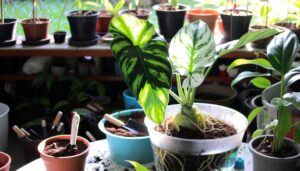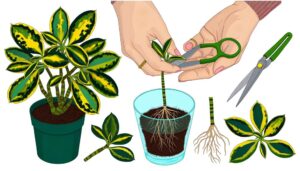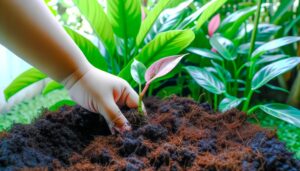Lemon Lime Philodendron Propagation
Propagating the Lemon Lime Philodendron (Philodendron hederaceum hybrid) involves several precise steps for best success. Utilize sterilized pruning shears to obtain stem cuttings about 4-6 inches long, ensuring each cutting has at least one node and vigorous, unblemished leaves.
Submerge the cuttings in dechlorinated water and place them in indirect sunlight, changing the water weekly to prevent stagnation. Roots should develop within 2-4 weeks.
Transfer the cuttings to a well-draining potting mix, ensuring good aeration and moisture retention. These critical steps enhance propagation efficacy and plant vigor.
For in-depth insights into each stage, further exploration might be beneficial.
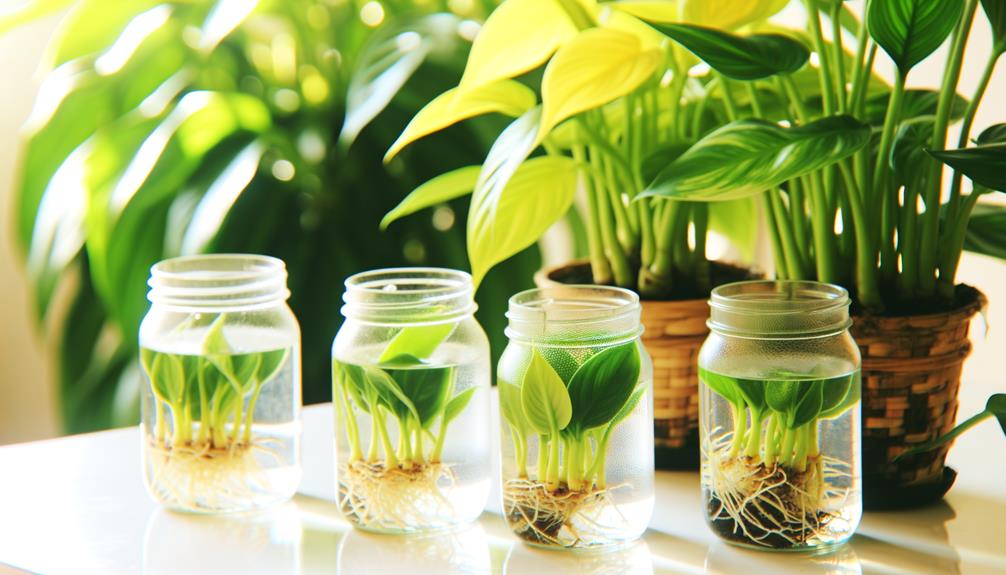
Key Takeaways
- Use healthy, vibrant stems with at least one node for successful Lemon Lime Philodendron propagation.
- Cut stem sections 4-6 inches long below the node using sterilized pruning shears.
- Submerge cuttings in dechlorinated water, change weekly, and place in indirect sunlight to encourage root growth.
- Transfer cuttings to a well-draining potting mix once roots develop, ensuring proper aeration and moisture retention.
- Apply hormone rooting powder to cuttings to enhance root development and increase propagation success rates.
Choosing the Right Tools
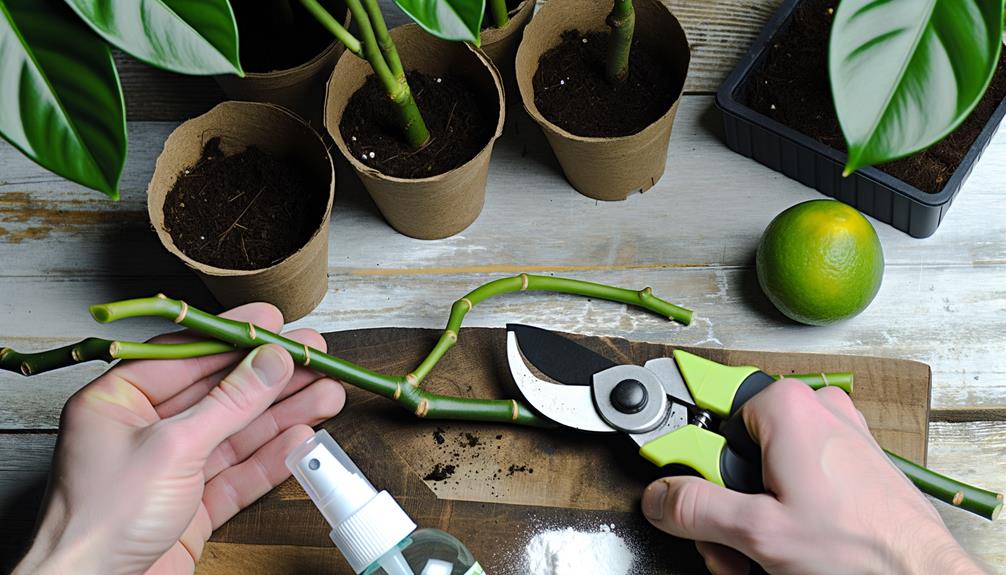
To successfully propagate a Lemon Lime Philodendron, it is crucial to select appropriate tools, including sterilized pruning shears, a clean cutting board, and hormone rooting powder. Sterilized pruning shears guarantee that pathogenic microorganisms do not infect the plant tissue during the cutting process.
A clean cutting board offers a contamination-free surface, minimizing the risk of disease transmission. Hormone rooting powder, rich in auxins such as indole-3-butyric acid (IBA), enhances root development by stimulating cell division and elongation. These tools are critical for optimizing the success rate of propagation and safeguarding the health of the new plantlets.
Proper preparation and tool selection are paramount for effective vegetative reproduction of Philodendron hederaceum ‘Lemon Lime,’ a cultivar renowned for its vibrant foliage.
Selecting a Healthy Stem
After assembling the necessary tools, the next step involves selecting a healthy stem from the parent Lemon Lime Philodendron to guarantee propagation success. It is crucial to choose a stem that exhibits prime vitality and vigor.
Key criteria include:
- Node Presence: Make sure the stem has at least one node, as nodes are crucial for root development and new growth.
- Leaf Health: Select a stem with vibrant, unblemished leaves, indicative of a strong photosynthetic process and nutrient distribution.
- Stem Integrity: Opt for a stem that is neither too young nor overly mature, preferring those of medium thickness to balance flexibility and structural strength.
Adhering to these criteria enhances the likelihood of successful root establishment and subsequent plant development.
Making the Cuttings
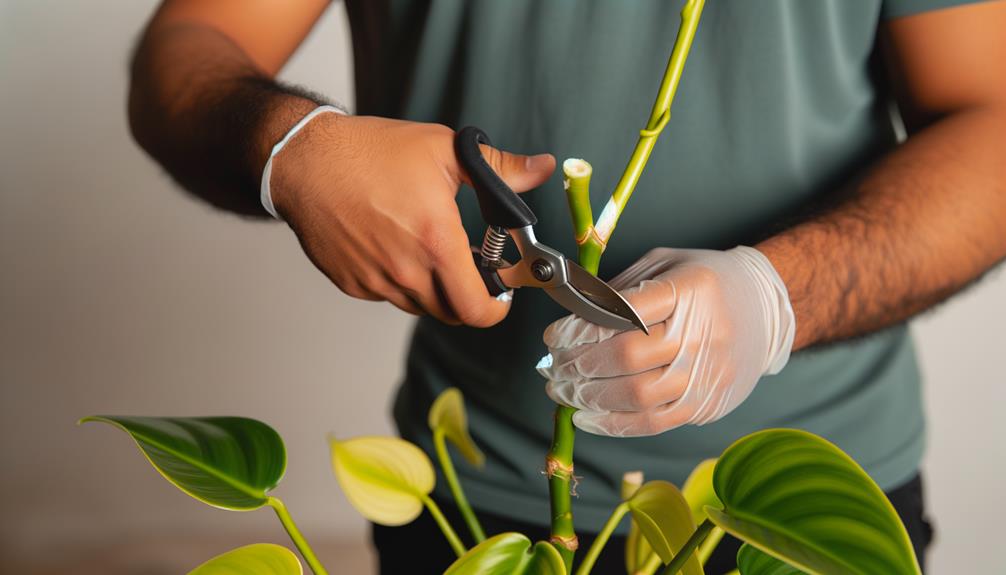
To begin the process of making cuttings from a Lemon Lime Philodendron, identify and select stems that exhibit strong health and vibrant coloration.
Confirm the selected stem sections are approximately 4-6 inches in length, incorporating at least one node, which is crucial for root development.
Utilize sterilized pruning shears to make precise cuts just below the node to promote best propagation success.
Selecting Healthy Stems
Promoting successful spread of Lemon Lime Philodendrons necessitates the choice of sturdy, disease-free stems displaying healthy foliage and active growth nodes. Prioritize stems that show no signs of pest infestation or fungal infection.
Key characteristics to take into account when selecting stems include:
- Robust Growth: Opt for stems with lively, solid leaves indicating active metabolic processes.
- Nodal Presence: Make sure the stem has at least one prominent node, as this is essential for root initiation.
- Coloration: Choose stems with the characteristic bright lemon-lime hue, as this coloration signifies excellent chlorophyll activity and nutrient balance.
Applying these criteria ensures the fundamental health of cuttings, thereby enhancing the likelihood of successful propagation.
Ideal Cutting Length
The best cutting length for Lemon Lime Philodendron propagation is approximately 4-6 inches, making sure each segment contains at least one node and a few healthy leaves. Cuttings of this size optimize the balance between nutrient storage and new root development (Salisbury & Ross, 1992).
Employ sterilized pruning shears to make clean, angular cuts just below a node, facilitating efficient water uptake and minimizing pathogen entry (Hartmann & Kester, 2011).
Confirm the cuttings exhibit vigorous, disease-free tissue. Place the cut segments in a moist, well-draining propagation medium, such as a peat-perlite mix, to promote root initiation (Raven et al., 2005).
Proper cutting length and preparation are crucial in achieving successful propagation outcomes in Lemon Lime Philodendron.
Node Identification
Identifying the nodes accurately on a Lemon Lime Philodendron is crucial for successful propagation, as these points are the sites where roots will emerge and new growth will initiate. Nodes are defined as the areas on the stem from which leaves, roots, and branches grow.
To guarantee precise identification and effective cuttings, observe the plant closely for the following:
- Leaf Nodes: These are where the leaves attach to the stem, often accompanied by aerial roots.
- Internodes: The segments between nodes; avoid cutting here as they lack the necessary meristematic tissues.
- Auxiliary Buds: Small bumps adjacent to leaf nodes, indicating potential for new growth.
Rooting in Water
One effective method for propagating a Lemon Lime Philodendron involves submerging cuttings in water to encourage root development.
Begin by selecting a healthy stem with at least one node and aerial root. Using a sterilized cutting tool, excise the stem segment below the node.
Immerse the cutting in a container filled with dechlorinated water, ensuring the node is fully submerged. Position the container in indirect sunlight to prevent algal growth and promote photosynthesis.
Change the water weekly to provide oxygen and prevent stagnation. Over a period of 2-4 weeks, nascent roots should emerge from the node. Observing root length and health is essential before proceeding to subsequent stages of propagation.
Transferring to Soil
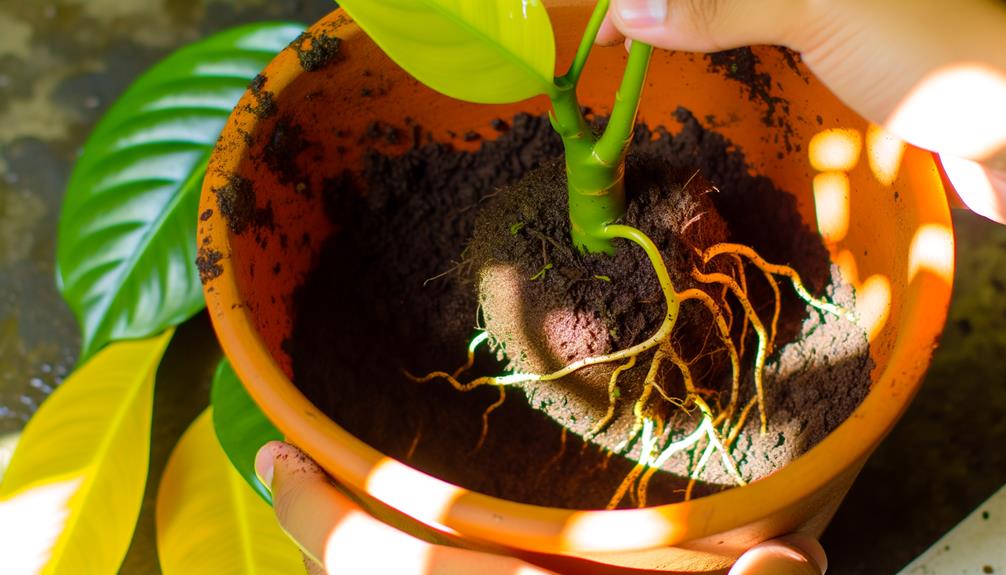
After successfully developing a strong root system in water, it’s important to move the Lemon Lime Philodendron cuttings to soil to guarantee continued growth and stability. This shift involves several critical steps to ensure the plant’s adaptation to its new environment:
- Soil Selection: Choose a well-draining potting mix comprising equal parts of peat moss, perlite, and vermiculite. This promotes ideal aeration and moisture retention, crucial for Philodendron growth.
- Pot Preparation: Select a pot with sufficient drainage holes. Fill it partially with the prepared soil mix, creating a space for the rooted cutting.
- Transplanting Process: Carefully remove the cutting from water, allowing any excess moisture to drain. Place it in the soil cavity, backfill around roots, and gently press the soil to secure the cutting.
These steps foster a favorable environment for root establishment and plant vitality.
Care After Propagation
Proper care after propagation is essential to secure the healthy growth and long-term health of your Lemon Lime Philodendron. Post-propagation, make sure the plant receives indirect sunlight, mimicking understory conditions of its native habitat.
Maintain soil moisture at a consistent level, avoiding waterlogging, which can lead to root rot (Rhizoctonia solani). Utilize a balanced, water-soluble fertilizer at half-strength bi-monthly to promote vigorous growth.
Monitor ambient humidity, targeting 60-70%, and consider using a humidity tray if necessary. Prune any yellowing leaves to allocate resources effectively. Regularly inspect for pests such as aphids and mealybugs, employing neem oil or insecticidal soap as needed.
This careful attention to post-propagation care will foster robust development and sustained health in your philodendron.
Conclusion
To sum up, the propagation of the Lemon Lime Philodendron is akin to nurturing a seedling into a flourishing tree; it demands precision, patience, and expertise.
By carefully selecting a healthy stem, making accurate cuttings, rooting in water, and eventually transferring to soil, ideal conditions for growth are established.
Such systematic practices guarantee the robust development of this botanical specimen, contributing to a thriving indoor garden ecosystem.

